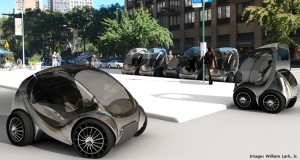MIT's radical proposal for an ultra-compact, foldable electric vehicle

BOSTON - Spent several days this week at an the EmTech@MIT emerging technology conference in Cambridge, Mass., where I was treated to demonstrations and theoretical discussions of innovations that could impact the way we work and live. Quite easily the most "holy cow" of those presentations was given by Ryan Chin, a doctoral student in the Smart Cities Group with the Massachusetts Institute of Technology (MIT) Media Lab. Chin and his colleagues are working on a project that would radically transform the face of urban transportation. The project was actually started by the late William Mitchell, who was an MIT Professor of Architecture and Media Arts and Sciences. (Think for a minute about holding that job title.)
In a nutshell, this MIT team is working on a foldable electric car or scooter, or an electric bicycle that you could rent or hire just to get from point A to point B around town. Yes, that's right, foldable. If you're a parent, think about how your baby's stroller works (or worked) and you'll get a notion of the concept. Here's an image of what the car prototype looks like.

I'll describe it in a moment, but first, here are the basic problems that Chin and the rest of the team are trying to solve:
- Current public transportation options, while they are improving and more people are taking advantage of them, have one major flaw. It's what Chin calls the "first mile, last mile" problem. That is, how you get too and from the bus stop or subway.
- Current cars and scooters, even the ones specifically targeted at urban applications, really weren't designed for cities. They can go 100 miles an hours, when the average speed in many cities is more like 15 or 20. They are focused on accommodating 300 miles for one trip. The reality is that 20 miles for a one-way trip is the average distance that many people in urban situations travel, according to Chin.
- Then, there's the whole density problem. There just isn't that much space to park or stick vehicles. There's some figure floating around that suggests something like 40 percent of the gasoline consumed in cities is burned looking for a parking space. I'm not quite so sure of that number, but I'm willing to buy that its a pretty high number.
The vehicles that the MIT team is working on fall into what Chin describes as a "Mobility on Demand" system, or one-way rental system that lets you grab a bike, scooter or car and just drive it one way to go that last mile or first mile on a trip. The concept is similar to the "car sharing" one evangelized by ZipCar, and the city of Paris currently has a system like this in place using bicycles. There's actually a consulting company in Washington, D.C., called MetroBike that is working on business models around this as well.
Here's how it would work. Say you've got a job interview or appointment in a nearby city. There's a great train schedule into the city center, but from there, you're facing an uptown journey of almost a mile and a half, one that isn't served by a local subway line. Do you leave extra time to walk? If you were going to a city that was using CityCars or one of the other vehicles that the team is working on, you could shave some time off the commute. You would simply swipe a credit card and drive the vehicle to the nearest depot.
So, what's real? First, you should know that this isn't a new project. I found references back at least six years, so it's more mature than you think.Credit: Michael Chia-Ling Lin
The RoboScooter is progressing through a deal with Samsung, according to Chin. It is meant to act at the equivalent of a 50cc gasoline-powered scooter.
The GreenWheel technology, which converts your existing bicycle into an electric one, is also moving along. Chin said the 300-watt technology, which uses batteries from A123, can hold a charge for about 20 miles.
What about the car?
Chin says a fullscale prototype of CityCar is anticipated in the summer of 2011. That prototype is being built by the Spanish company commercializing these technologies, Hiriko. Cities that will be targeted for tests include Singapore, Boston, Taipei and Florence, Italy.
Here are some design points:
- The car will weigh less than 1,00 pounds. Like I said, it folds vertically (think of a cat arching its back). Chin says that you'll be able to fit three CityCars into a conventionally sized parking spot. (It's about 60 percent the size of a Smart Car.)
- The vehicle is meant to hold two passengers, and you actually enter from the front. The way that the car can turn (its wheels can articulate) means that you can actually step out onto the sidewalk once the vehicle is in place.
- There is no centralized engine for the vehicle. The drive mechanism is actually in the wheels themselves.
- The design uses Lithium-ion batteries that are housed in the floor.
- You can fast-charge the batteries in as little as 15 minutes.
- The cars are assembled in a component design. So, for example, the wheels could snap on and off, which is meant to help with servicing.
- The cost to produce the car is hopefully around $18,000, but Chin admits this price point is a bit "academically dishonest." That's because it doesn't account for the cost of building the charging infrastructure.
Here are some of the rather thoughtful questions that came up at the end of the presentation:
- What about safety? What would happen if you were rear-ended, as an example? According to Chin, this isn't a huge consideration because the cars are meant to be driven in low-speed situations. BUT, if you did get into a fender bender, the vehicle would fold, which would help absorb the impact. The team IS working on side-impact safety features, because you don't get in and out that way. Chin says that the vehicle will also be built to contain all the active safety features you would expect.
- How do you manage the fleet? In other words, how do you stop vehicles from "pooling" in certain locations while none are in other locations? Chin say one answer might lie in creating a premium pricing infrastructure. So, for example, you might get charged a little bit less if you choose to drop off the car in a location that would help balance supply.
- How do you make sure people aren't careless with these vehicles? Chin says that democratizing access helps with accountability. Also, by tying them to some sort of community ownership, people might be more sensitive.
You might imagine situations where businesses could use CityCar as an incentive or a perk for employees. Or, alternatively, as a means of keeping their costs lower. One example cited by Chin would be a condominium association hoping to avoid building out a massive parking garage to accommodate conventionally sized vehicles. By building a charging infrastructure and giving out cars, it could cut costs
Chin also says the charging infrastructure itself could help with urban demand response for the electric grid. A fleet of 4,000 CityCars would require a charging infrastructure of about 20 megawatts, which ends up being about the right amount to charge the entire city of Boston for two minutes. If necessary, that capacity could help with peak shaving, he suggests.
For all its cool-ness, I have a rough time seeing Americans adapting quickly to this radical new concept for electric transportation. But Rome wasn't built in a day, either.
This post was originally published on Smartplanet.com